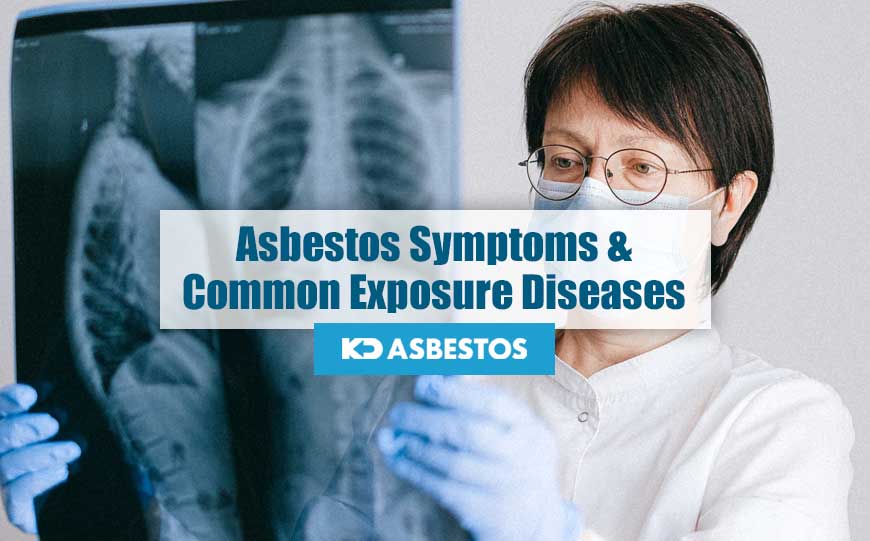Asbestos exposure symptoms can often be elusive, creeping up on the unsuspecting individual in a rather insidious manner. This remarkable yet troubling phenomenon has garnered attention due to its dire consequences on health, particularly in specific occupational settings where exposure is rampant. In this exploration, we shall delve into the common and lesser-known symptoms associated with asbestos, illustrating the timeline of their emergence and the serious health conditions they may precipitate.
Understanding the nuances of these symptoms not only empowers individuals to recognise potential health threats but also underscores the importance of preventive measures, particularly for those in high-risk occupations. With a focus on the various health implications and risk factors, we aim to illuminate the critical aspects of this pressing issue.
Identification of Asbestos Exposure Symptoms
Asbestos exposure presents a myriad of health concerns, often manifesting as various symptoms that may develop many years after initial contact with the material. Understanding these symptoms is crucial for early detection and management of potential health issues associated with asbestos. Both common and lesser-known symptoms may surface, warranting a comprehensive grasp of the associated health risks.
The onset of symptoms related to asbestos exposure can be insidious, with latency periods ranging from several years to decades. Many individuals may not exhibit any noticeable signs until the damage has progressed significantly. This delayed manifestation complicates diagnosis and treatment, emphasizing the importance of awareness regarding the symptoms that may arise post-exposure.
Common Symptoms of Asbestos Exposure, Asbestos exposure symptoms
Recognising the primary symptoms associated with asbestos exposure is essential for timely intervention. The most prevalent signs include:
- Shortness of Breath: Often the first noticeable symptom, it results from compromised lung function.
- Persistent Cough: A chronic cough may develop as a response to irritation in the lungs.
- Chest Pain: Discomfort or pain in the chest can indicate significant lung disease.
- Fatigue: General tiredness may occur as the body struggles to function normally.
- Weight Loss: Unintended weight loss can be a result of chronic illness and reduced appetite.
Symptom Development Timeline
The timeline for the development of symptoms after asbestos exposure varies considerably among individuals, largely dictated by the extent and duration of exposure. Typically, symptoms may not surface until 10 to 40 years after initial contact. Regular health monitoring and assessment are vital for those with known exposure histories, as early-stage symptoms can be subtle yet significant.
Less-Known Symptoms of Asbestos Exposure
While the common symptoms are well-documented, a range of lesser-known symptoms can also arise, often leading to further complications. These include:
- Clubbing of Fingers: A deformity in the fingers or toes characterised by an enlarged, rounded appearance.
- Difficulty Swallowing: Also known as dysphagia, it may occur as a result of esophageal involvement.
- Hoarseness: Changes in voice quality can signal underlying respiratory issues.
- Night Sweats: Excessive sweating during sleep may indicate systemic illness.
- Fluid Accumulation in the Chest: Known as pleural effusion, this condition can cause significant respiratory distress.
“Early identification of asbestos-related symptoms is pivotal in managing potential long-term health consequences.”
Health Conditions Related to Asbestos Exposure

Asbestos exposure has been linked to a plethora of serious health conditions, primarily affecting the respiratory system. The fine, fibrous structure of asbestos allows it to become airborne and inhaled, making it particularly hazardous to health. Understanding these conditions is vital for those who may have been exposed and for preventive health measures.
The most notable diseases linked to asbestos exposure include asbestosis, lung cancer, and mesothelioma. Asbestosis is a chronic lung condition caused by the inhalation of asbestos fibres, leading to lung scarring and impaired lung function. Mesothelioma, on the other hand, is a rare but aggressive cancer primarily affecting the lining of the lungs and is almost exclusively associated with asbestos exposure. The relationship between these diseases and asbestos is underscored by the latency period, which can span decades before symptoms manifest.
Asbestosis and Lung Cancer
Asbestosis and lung cancer represent two of the most significant health conditions resulting from asbestos exposure.
Asbestosis is characterised by inflammation and scarring of the lung tissue. Symptoms often include persistent cough, shortness of breath, and chest tightness, which progressively worsen over time. The risk of developing lung cancer is significantly heightened in individuals with asbestosis, especially those with a history of smoking. The synergistic effect of asbestos and tobacco smoke exacerbates the likelihood of developing malignancies.
Lung cancer resulting from asbestos exposure is not limited to primary lung cancer but also includes cancers of the trachea and bronchus. The World Health Organization has classified asbestos as a known carcinogen, with a pronounced risk of developing lung cancer after prolonged exposure. It is important to note that while the risk increases with the duration and intensity of exposure, even short-term exposure can lead to serious health implications.
Comparative Analysis of Short-term vs. Long-term Health Risks
Assessing the health risks associated with asbestos exposure reveals a stark contrast between short-term and long-term exposure consequences.
Short-term exposure to asbestos may lead to acute respiratory issues such as irritation and inflammation of the lungs, often presenting as coughing or difficulty breathing. However, the long-term health risks are considerably more severe and insidious.
Long-term exposure elevates the likelihood of developing chronic conditions, notably asbestosis and malignant diseases such as lung cancer and mesothelioma. The cumulative effect of inhaling asbestos fibres over many years can result in irreversible lung damage, significantly affecting quality of life and overall health.
A crucial aspect to consider is the latency period associated with asbestos-related diseases; symptoms may not appear until 20 to 50 years after exposure. Therefore, individuals with a history of exposure should be vigilant about regular health check-ups, as early diagnosis can be crucial in managing these conditions effectively.
Asbestos exposure is a significant health hazard, with long-term implications that can manifest decades after initial contact.
Risk Factors and Vulnerable Populations

Certain groups of individuals display heightened vulnerability to asbestos exposure and its associated health implications. Understanding these demographics is crucial, as it informs preventative action and regulatory measures within at-risk communities. The following sections examine the populations at a greater risk, specific occupational settings conducive to asbestos exposure, and certain demographic factors that exacerbate the likelihood of severe symptoms arising from such exposure.
Populations at Higher Risk for Asbestos Exposure
Specific populations are historically identified as being at an elevated risk for asbestos exposure. These individuals often experience prolonged or intense exposure due to their occupational or environmental conditions. Notably, the following groups are particularly vulnerable:
- Construction workers engaged in building, renovation, or demolition activities.
- Shipyard workers involved in shipbuilding or repairing processes.
- Asbestos miners and those working in asbestos manufacturing settings.
- Electricians and plumbers who may handle asbestos-containing materials.
- Firefighters who may encounter asbestos during their duties in older buildings.
- Workers in textile industries where asbestos fibres may be present in products.
Occupational Settings with Prevalent Asbestos Exposure
The risk of asbestos exposure significantly correlates with specific occupational settings. These environments often prioritise task completion over safety, leading to increased risk for employees. The following list highlights key industries where asbestos exposure remains prevalent:
- Construction and demolition sites
- Shipbuilding and repair yards
- Manufacturing of asbestos products
- Electrical and plumbing work
- Textile manufacturing
- Mining operations
Demographic Factors Increasing Likelihood of Severe Symptoms
Certain demographic factors can exacerbate the health implications stemming from asbestos exposure. These factors can influence the severity of symptoms experienced, as well as the likelihood of developing associated diseases. The following elements are critical to consider:
- Age: Older individuals generally have a higher susceptibility due to prolonged exposure over time.
- Gender: Studies have indicated that males are often more affected, likely due to higher representation in high-risk occupations.
- Smoking status: Smokers who also have asbestos exposure face a significantly increased risk of lung cancer.
- Pre-existing health conditions: Individuals with respiratory or cardiovascular diseases may experience worsened outcomes from asbestos exposure.
- Duration of exposure: Longer exposure periods correlate with a higher incidence of severe symptoms and associated health conditions.
Understanding risk factors and vulnerable populations is essential for effective asbestos management and health protection strategies.
Prevention and Safety Measures: Asbestos Exposure Symptoms

Effective prevention and safety measures are vital in minimising asbestos exposure, particularly in occupational settings where risk is heightened. With national guidelines and regulations in place, it is imperative that both employers and employees are well-informed about the protocols to follow in order to mitigate the risks associated with asbestos.
Safety Measures in the Workplace
Implementing effective safety measures in the workplace involves a multi-faceted approach. Firstly, it is essential to conduct regular risk assessments to identify potential asbestos presence, particularly in older buildings. Employers should ensure that all employees are trained in asbestos awareness, enabling them to recognise materials that may contain asbestos.
Furthermore, the following safety protocols should be adhered to:
- Use of appropriate personal protective equipment (PPE) such as respirators, protective clothing, and gloves when working in areas suspected of containing asbestos.
- Establishment of clear signage to warn of asbestos hazards in affected areas.
- Implementation of strict hygiene practices, including decontamination procedures for equipment and personnel after working in asbestos-related environments.
Safe Handling During Renovation or Demolition
When engaging in renovation or demolition work in older structures, it is crucial to follow stringent safety guidelines to avoid asbestos exposure. Prior to commencing any work, a thorough asbestos survey should be conducted by a qualified professional. This ensures that asbestos-containing materials are identified and appropriate removal strategies can be implemented.
Important procedures include:
- Engaging licensed asbestos removal contractors to handle any identified asbestos materials.
- Encapsulating or sealing asbestos materials that cannot be removed safely, thereby preventing the release of fibres into the air.
- Ensuring that all work areas are adequately isolated and that proper air monitoring is in place to detect any airborne asbestos fibres during the renovation process.
Risk Assessment Checklist for Individuals
Individuals can assess their risk of asbestos exposure by utilising a straightforward checklist. This checklist serves as a practical tool for identifying potential hazards in residential or workplace environments.
The checklist includes:
- Is the property older than 2000? Properties built before this date are more likely to contain asbestos materials.
- Have you conducted an inspection for any potential asbestos-containing materials, such as insulation, floor tiles, or roofing materials?
- Have you reviewed any available maintenance or construction records that may indicate asbestos presence?
- Are you aware of the presence of any ongoing renovations or maintenance work that may disturb asbestos materials?
By adhering to these prevention and safety measures, individuals and employers alike can significantly reduce the risks associated with asbestos exposure, ultimately leading to safer working and living environments.
If you’re considering renovations, be cautious of popcorn ceiling asbestos , which can pose serious health risks. It’s essential to identify whether your ceiling contains this hazardous material before proceeding. On a different note, for those aspiring to enhance their creative skills, pursuing an online graphic design degree offers a flexible pathway to develop your artistic talents while balancing other commitments.
When tackling home improvements, one must be aware of the dangers of popcorn ceiling asbestos. If your ceiling has this texture, it’s wise to consult professionals for safe removal. Conversely, if you fancy a career in the arts, consider enrolling in an online graphic design degree , which allows you to build valuable skills at your own pace, equipping you for the modern workforce.